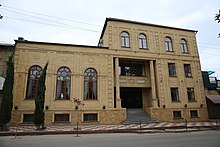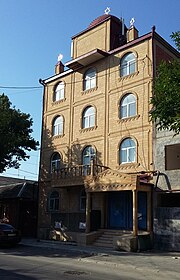Judaism in Dagestan is mainly practiced by Mountain Jews. By the beginning of the 8th century BCE Mountain Jews had reached Persia from Israel.[1] Under the Sasanian Empire, with the arrival in Dagestan of Iranian-speaking tribes from the north, they settled in different regions of the Caucasus.[2]


According to the 2002 census, there were 3.4 thousand Jews in Dagestan (in Makhachkala - 430 Jews (0.08%), Mountain Jews - 61 people (0.01%). [3]
History
editReferences to the Jewish communities existing in the Caucasus are found in the works of Armenian, Georgian and Arab historians. In particular, Faustus of Byzantium, Elishe, Movses Kaghankatvatsi, Movses Khorenatsi and Al-Masudi. This is also evidenced by historical field research, which reveals many legends associated with the existence of Judaism in the region. Petroglyphs with the star of David and other symbols of the Jewish faith have been found in many regions of Dagestan. The toponymy of the North-Eastern Caucasus has preserved many names associated with the Jews. In particular, the mountain village of Tabasaransky District is called Dzhugud-kala (literally, “Jewish fortress”, “fortress of the Jews”); the gorge near Madzhalis is Dzhut-Gatta, and the mountain in this area is Dzhufudag, which is, the “Jewish Mountain”.[4]
The settlement area of Mountain Jews completely coincides with the territory occupied by the Sasanian settlers during the times of Kavad I and Khosrow I Anushirvan. Almost all chronicles from written sources, toponymy, petroglyphs and folklore related to Judaism were recorded precisely on those lands where functioned the border posts of the Sassanids and then the Arabs: in modern Derbentsky, Tabasaransky, Kaytagsky, Suleyman-Stalsky, Khivsky, Magaramkentsky, Akhtynsky, Rutulsky, Agulsky districts of Dagestan. Moreover, it was in those settlements that were the strongholds of those boards (Dzhalgan, Jarrakh, Nyugdi, Khanzhalkala, Mamrach, etc.). The material traces of Jewish communities are best preserved in the vicinity of Derbent, as well as on the lands of historical Tabasaran and Kaytag.[4]
Adam Olearius, who visited Dagestan in the first half of the 17th century, writes about the Jewish population of Kaitag, Tabasaran and Derbent. He noted:
Now there are many, many Jews living in Tabasaran.
In another place he wrote:
There are no Christians in the city of Derbent, as some writers say; only Mohammedan and Jews live here, writing themselves from the tribe of Benjamin.[5]
The same words are repeated in the work of Jan Jansen Struys, a Dutch traveler who visited Dagestan in 1670:
There are no Christians in the city of Derbent, but only Mohammedans and a few Jews.[6]
Faustus of Byzantium writes that Armenian king Tigranes the Great (95 – 55 BC) brought Jews in for the first time from Palestine to Caucasus and settled them in mountain gorges in the 1st century BC. The Jewish colonists remained an influential military force in the Caucasus for many centuries, until the conquest of Armenia by Shapur II (309 – 379 BC) carried out a devastating campaign in Armenia, led away tens of thousands of Jewish colonists and settled them in Iran.[4]
Modern times
editIn the 2000s Dagestan had 4 synagogues, of which three were in Makhachkala, Derbent, Buynaksk, one prayer house was in Khasavyurt. In Derbent, there is a Jewish community and the Sephardic synagogue "Kele-Numaz". Also, Vatan, the only newspaper in Russia in the Mountain Jewish language (Juhuri). There are only 6 clergymen of the Jewish religious denomination operating in Dagestan (community chairmen, cantors and acting rabbis). Sunday schools functioned at the synagogues. There were no higher and secondary Jewish educational institutions in the republic.[3]
Amidst the 2023 Hamas-Israel war, there were a wave of anti-semitic attacks in Dagestan and other areas in the North Caucasus. In one case, a group waving Palestinian flags and chanting anti-semitic slogans forcefully entered the Makhachkala airport. Their target was Israeli and Jewish travelers arriving on a flight from Tel Aviv. The incident resulted in about 20 injuries, as reported by local health authorities. Passports of some passengers were scrutinized by the crowd. Meanwhile, in the nearby city of Khasavyurt, protesters surrounded a hotel, suspecting it accommodated Jewish tourists.[7][8]
On June 23, 2024, Islamist terrorists burned the Jewish synagogue in Derbent.[9][10]
See also
editReferences
edit- ^ Goluboff, Sascha (Mar 6, 2012). Jewish Russians: Upheavals in a Moscow Synagogue. University of Pennsylvania. p. 125. ISBN 978-0812202038.
- ^ Абдулаева И. А. Моральная система ценностей в авраамистических религиях на примере традиционных черт иудаизма в Дагестане // Наука и современность. 2011. №8-3.
- ^ a b Халидова О. Б. Евреи на постсоветском религиозном пространстве Дагестана: особенности и проблемы в национальном регионе //Религиоведение. – 2020. – №. 4. – С. 95-101.
- ^ a b c Казиханова А.А., Абдулпатахова Х.М. К ВОПРОСУ О РАСПРОСТРАНЕНИИ ИУДАИЗМА В ХАЗАРИИ // Вестник Дагестанского государственного университета. Серия 2: Гуманитарные науки. 2006. №3.
- ^ Олеарий А. Описание путешествия в Московию и через Московию в Персию и обратно. – СПб.: Изд. А.С. Суворова, 1906.
- ^ Стрейс Я.Я. Три путешествия // Дагестан в известиях русских и западноевропейских авторов XIII – XVIII вв. / Под ред. В.Г. Гаджиева. – Махачкала, 1992.
- ^ "Hundreds storm airport in Russia in antisemitic riot over arrival of plane from Israel - CBS News". www.cbsnews.com. 2023-10-30. Retrieved 2023-10-30.
- ^ "Anti-Israel mob storms Dagestan airport in Russia". BBC News. 2023-10-29. Retrieved 2023-10-30.
- ^ Terrorists burned the Jewish synagogue in Derbent. 06-23-2024.
- ^ Nightmare in Dagestan. 06-23-2024.
External links
editMedia related to Judaism in Dagestan at Wikimedia Commons